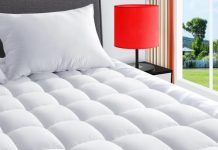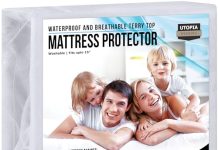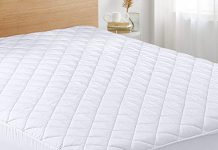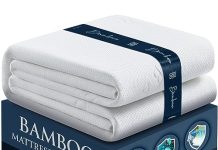Are allergies getting the best of you? If so, you’ll be glad to know that there may be a simple solution on the horizon – a latex mattress topper. This article explores the potential benefits of using a latex mattress topper to alleviate allergy symptoms. Say goodbye to sleepless nights and constant sneezing, as we uncover how this natural material could be the secret weapon against those pesky allergies.
This image is property of images.unsplash.com.
Review contents
What is a latex mattress topper?
A latex mattress topper is a cushioning layer that is placed on top of a mattress to provide added comfort and support. It is designed to enhance the sleeping experience by adjusting to the contours of the body, reducing pressure points, and promoting better spinal alignment. Latex mattress toppers are made from latex foam, a natural material derived from the sap of rubber trees. This makes them an eco-friendly and sustainable choice for those seeking a more natural sleep surface.
Composition of a latex mattress topper
Latex mattress toppers are typically made from either natural latex or synthetic latex. Natural latex is derived from the sap of rubber trees and is known for its durability, breathability, and hypoallergenic properties. Synthetic latex, on the other hand, is a man-made material that is designed to mimic the properties of natural latex. It is often more affordable than natural latex but may not offer the same level of support and comfort.
Types of latex used in mattress toppers
There are two main types of latex used in mattress toppers: Dunlop latex and Talalay latex. Dunlop latex is known for its firmness and durability. It has a denser structure and is recommended for those who prefer a firmer sleep surface. Talalay latex, on the other hand, is known for its softer and more luxurious feel. It has a lighter and more breathable structure, making it ideal for those who prefer a softer and more plush sleep surface.
Common Symptoms of Allergies
Allergies can manifest in various ways, and it is important to be aware of the common symptoms that may indicate an allergic reaction. While the specific symptoms may vary from person to person, there are three main categories of allergy symptoms: respiratory symptoms, skin symptoms, and eye symptoms.
Respiratory symptoms
Respiratory symptoms of allergies may include sneezing, coughing, wheezing, shortness of breath, and a runny or stuffy nose. These symptoms are often triggered by allergens such as dust mites, pet dander, pollen, and mold.
Skin symptoms
Skin symptoms of allergies may include itching, redness, rashes, hives, and swelling. These symptoms are often triggered by allergens such as certain fabrics, chemicals, latex, or specific ingredients in skincare products.
Eye symptoms
Eye symptoms of allergies may include redness, itching, watering, and swelling of the eyes. These symptoms are often triggered by allergens such as pollen, dust mites, pet dander, and certain chemicals.
Understanding Allergies to Mattresses
Mattresses can harbor a variety of allergens that can trigger allergic reactions in sensitive individuals. Understanding the common allergens found in mattresses and how allergies to mattresses manifest can help in finding effective solutions.
Common allergens found in mattresses
Common allergens found in mattresses include dust mites, mold, pet dander, and pollen. Dust mites are microscopic creatures that thrive in warm and humid environments. They feed on dead skin cells and their droppings can trigger allergic reactions. Mold can grow in damp environments and release spores that can cause respiratory symptoms. Pet dander, which consists of tiny particles of skin shed by animals, can also trigger allergies in some individuals. Pollen can enter the bedroom through open windows or on clothing and bedding, and can cause allergic reactions in sensitive individuals.
How allergies to mattresses manifest
Allergies to mattresses can manifest in various ways, including respiratory symptoms such as sneezing, coughing, wheezing, and nasal congestion. Skin symptoms such as itching, rashes, and hives may also occur. Additionally, allergic reactions to mattresses can cause eye symptoms such as redness, itchiness, and watering.
How a Latex Mattress Topper Works
A latex mattress topper can provide an effective solution for those with allergies to mattresses. Here’s how it works:
Barrier against allergens
A latex mattress topper acts as a barrier between the sleeper and the mattress, preventing direct contact with allergens such as dust mites, mold, and pet dander. This can help reduce the risk of allergic reactions and provide a more comfortable and allergen-free sleep environment.
Preventing allergen accumulation
Latex is naturally resistant to dust mites, mold, and mildew, making it an ideal material for allergy sufferers. Unlike traditional mattresses that can accumulate allergens over time, latex mattress toppers are less prone to harboring these allergens. This can help minimize the risk of allergies and create a cleaner and healthier sleep surface.
Easy to clean and maintain
Latex mattress toppers are relatively easy to clean and maintain. They can be spot cleaned or vacuumed to remove any surface allergens. Furthermore, latex is naturally antimicrobial, which means it inhibits the growth of bacteria and mold. This makes latex mattress toppers a hygienic choice for those with allergies.
This image is property of images.unsplash.com.
The Benefits of Using a Latex Mattress Topper for Allergies
Using a latex mattress topper for allergies offers several benefits:
Hypoallergenic properties
Latex, especially natural latex, is known for its hypoallergenic properties. It is resistant to dust mites, mold, and mildew, which are common allergens found in mattresses. By using a latex mattress topper, individuals with allergies can create a barrier between themselves and these allergens, reducing the risk of allergic reactions and promoting a healthier sleep environment.
Resistance to dust mites
Dust mites are one of the most common triggers for allergies, particularly respiratory allergies such as asthma and rhinitis. Dust mites thrive in warm and humid environments, and mattresses provide an ideal habitat for their growth. However, latex mattress toppers are naturally resistant to dust mites, making them an excellent choice for allergy sufferers.
Mold and mildew prevention
Mold and mildew can grow in damp environments and release spores that can trigger allergies. Traditional mattresses can accumulate moisture over time, providing a breeding ground for mold and mildew. Latex mattress toppers, on the other hand, have natural antimicrobial properties that help prevent the growth of mold and mildew. This can significantly reduce the risk of allergies and create a healthier sleep environment.
Choosing the Right Latex Mattress Topper for Allergies
When selecting a latex mattress topper for allergies, there are a few key considerations to keep in mind:
Natural latex vs synthetic latex
Natural latex is derived from the sap of rubber trees and is known for its natural hypoallergenic properties. It is a more sustainable and eco-friendly choice, but it may come with a higher price tag. Synthetic latex, on the other hand, is a man-made material that is designed to mimic the properties of natural latex. While it may be more affordable, it may not offer the same level of hypoallergenic protection. Individuals with severe allergies may prefer natural latex for its superior allergy-resistance.
Thickness and density considerations
Latex mattress toppers come in different thicknesses and densities, and the right choice will depend on individual preferences and needs. The thickness of the topper can affect the level of support and cushioning it provides. A thicker topper may be more suitable for those seeking additional pressure relief and comfort. Density refers to the weight and durability of the latex foam. A higher density topper may offer better longevity and support, but it may also be firmer. Consider personal preferences and any specific allergy concerns when selecting the thickness and density of a latex mattress topper.
Certifications for allergen-free materials
Look for latex mattress toppers that have been certified as allergen-free. Certifications such as OEKO-TEX or Global Organic Latex Standard (GOLS) ensure that the materials used in the topper meet strict standards for allergen content and production processes. These certifications provide peace of mind and assurance that the topper is free from harmful substances and allergens.
This image is property of images.unsplash.com.
Other Strategies to Reduce Allergens in the Bedroom
In addition to using a latex mattress topper, there are several other strategies that can help reduce allergens in the bedroom:
Regular mattress cleaning
Regularly cleaning and vacuuming the mattress can help remove allergens such as dust mites, pet dander, and pollen. Use a vacuum cleaner with a HEPA filter to effectively trap these allergens and prevent them from becoming airborne.
Encasing mattresses and pillows
Using allergen-proof encasements for mattresses and pillows can create a barrier against allergens. These encasements are made of tightly woven fabrics that prevent allergens from penetrating the mattress or pillow.
Frequent washing of bedding
Washing bedding, including sheets, pillowcases, and blankets, in hot water can help remove allergens. High temperatures effectively kill dust mites and remove pet dander and pollen. It is recommended to wash bedding weekly or every two weeks to keep it clean and allergen-free.
Individual Considerations and Allergy Testing
While a latex mattress topper can be beneficial for many allergy sufferers, it is important to consider individual sensitivities and triggers. Consulting with an allergist can help identify specific allergens and determine the best course of action. An allergist can perform allergy testing to pinpoint the exact allergens that may be causing symptoms. This information can be used to make informed decisions when selecting a latex mattress topper or implementing other allergy-reducing strategies.
Personal sensitivities and triggers
Each individual may have unique sensitivities and triggers when it comes to allergies. Some people may be more sensitive to certain allergens, while others may have multiple allergies. Identifying personal sensitivities and triggers can help tailor the approach to managing allergies and selecting the most suitable products, such as a latex mattress topper.
Testing for latex allergies
It is important to note that a small percentage of individuals may have allergies or sensitivities to latex itself. Latex allergies can cause skin reactions, respiratory symptoms, and even life-threatening anaphylaxis in severe cases. If there is a known latex allergy or if symptoms such as skin itching or difficulty breathing occur when in contact with latex products, it is advisable to avoid latex mattress toppers or opt for alternatives.
Potential Risks and Side Effects of Latex Mattress Toppers
While latex mattress toppers can be beneficial for many individuals, it is important to be aware of potential risks and side effects:
Latex allergies and sensitivities
As mentioned earlier, some individuals may have allergies or sensitivities to latex. Symptoms can range from mild skin irritations to severe respiratory reactions. It is essential to identify any latex allergies before using a latex mattress topper. If there is a known latex allergy, it is best to consult with a healthcare professional and consider alternative materials for allergy management.
Off-gassing of synthetic latex
Synthetic latex mattress toppers may release certain chemicals, known as volatile organic compounds (VOCs), during the initial period of use. This off-gassing can cause a strong odor and may be a concern for individuals with respiratory sensitivities. Selecting a natural latex mattress topper can help minimize the risk of off-gassing and exposure to VOCs.
Proper selection and usage to minimize risks
To minimize potential risks and side effects of latex mattress toppers, it is important to select a high-quality product that meets safety standards. Follow the manufacturer’s instructions for proper usage and maintenance. If any adverse reactions occur, discontinue use and seek medical advice.
Conclusion
A latex mattress topper can be a valuable addition to the bedroom for those with allergies. Its hypoallergenic properties, resistance to dust mites, and mold prevention capabilities make it an excellent choice for creating an allergen-free sleep environment. By understanding the common symptoms of allergies, the allergens found in mattresses, and how latex mattress toppers work, individuals can make informed decisions and improve their sleep quality. Consider personal preferences, consult with an allergist if necessary, and choose a latex mattress topper that meets individual needs and requirements. With the right precautions and strategies, allergies can be effectively managed, allowing for a restful and comfortable night’s sleep.






























